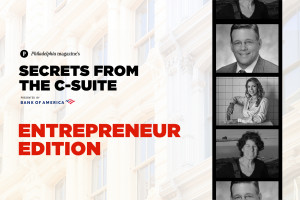This Philly HR Startup Wants to Make Your Workplace More Efficient
Employee Cycle’s analytics dashboard helps HR professionals easily track and analyze “people data” — information on diversity, recruitment and turnover.

Employee Cycle founders Salas Saraiya (L) and Bruce Marable (R). Courtesy photo
For many workers, the human resources (HR) department only comes to mind when they’re hired, fired, or involved in some workplace quandary. But HR departments are responsible for managing so much more behind the scenes — like heaps of data on employee wages, benefits, and turnover. A new Philly startup wants to help HR professionals better compile this information, freeing these leaders up to make informed decisions that improve the workplace. With its recent successful beta launch, Employee Cycle provides clients with an all-in-one HR analytics dashboard. BizPhilly talked to Bruce Marable, the startup’s CEO, to learn more about the company’s desire to shake up the HR industry.
BizPhilly: If you had to explain your product to someone with no HR knowledge, what would you say?
Marable: Companies hire HR professionals to manage all aspects of the employee experience. This includes hiring, onboarding, paying, engaging, and retaining employees. Typically, companies will purchase multiple HR software systems to manage these different aspects of HR, like payroll software and recruiting software. Since these various HR software systems collect valuable data about the workforce, HR leaders need to leverage this data to make better workforce decisions. But the data being held in disconnected data silos makes the process more difficult than it needs to be.
Employee Cycle is a HR dashboard that connects to those different HR software systems, and automatically pulls and transforms the most important employee data from each system into one centralized real-time view. This allows HR leads to view, track, analyze and share “people data” to become smarter and more data-driven.
You raised $475K. What was it like pitching Employee Cycle to investors?
The process of raising capital for a startup is always somewhere between very exciting and very stressful, and as CEO I found myself being on different sides of that spectrum. When we first started to raise investment, one of the biggest lessons we learned was about telling the right story. We got feedback that the story we were telling sounded more like a sales pitch to a customer versus an investment pitch, and once we were able to better tailor our story to the investor audience, we started to see some traction.
Also, most investors are not deeply familiar with the HR role and their most pressing business issues, so there was a lot of education required for investors to have confidence about the market need and demand.
To overcome those barriers, we built a working prototype, acquired paying customers, and recorded customer interviews before we raised a dime of funding to show early proof of an addressable market. That helped signal that we could identify a unique problem not being solved, execute on product development to solve that problem, and get customers to pay to solve that specific problem. That entire process gave investors enough confidence to believe we could achieve our next set of milestones with the funding they provided.
What differentiates Employee Cycle from other platforms in this industry?
Employee Cycle is differentiated in a few key areas. First, Employee Cycle is the first freemium self-service HR-specific dashboard on the market. With our competitors requiring a setup process and fee, we’re offering the opportunity for customers to “try before you buy,” removing friction in the customer adoption process. We’re also strategically targeting small and medium-size companies with 100 to 1,000 employees. This market has been severely overlooked, with competitors aggressively competing for the mid-market and enterprise markets. Targeting this market allows us to integrate and partner with more HR systems that also target smaller companies. We also provide a data coaching service to help HR leaders align their HR metrics with company goals.
How might Employee Cycle help tackle a lack of diversity in the workplace, the gender pay gap, and high employee turnover rates?
As the cliche goes, “what gets measured gets managed.” HR is no exception. When HR doesn’t have the quick and accessible transparency around negative workforce trends, including growing the team without any diverse representation, turnover rates increasing in specific departments or locations, or the gender pay gap exponentially increasing over time, it doesn’t become a top priority. Our goal is to help build a data-driven HR practice as early in the life of our customers as possible, allowing the company to grow with a core focus on these types of workforce issues.
What’s the next step for Employee Cycle following this launch?
The primary goal after launch is to achieve the strongest product-market-fit. For us, that looks like our customers using our product on a consistent basis, and embedding the product into their workflow of viewing, tracking, sharing, and analyzing HR data to make better workforce decisions. The more we truly understand our customers, the more empathy we’ll have to continue to offer the best product possible. We are also putting a significant amount of effort forward to educate our target market that a product exists for the problem they’re currently solving manually, since we’re helping to define the HR dashboard market.


